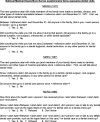Comparing oral health care utilization estimates in the United States across three nationally representative surveys
- PMID: 12036005
- PMCID: PMC1430363
- DOI: 10.1111/1475-6773.034
Comparing oral health care utilization estimates in the United States across three nationally representative surveys
Abstract
Objective: To compare estimates of dental visits among adults using three national surveys.
Data sources/study design: Cross-sectional data from the National Health Interview Survey (NHIS), National Health and Nutrition Examination Survey (NHANES), and National Health Expenditure surveys (NMCES, NMES, MEPS).
Study design: This secondary data analysis assessed whether overall estimates and stratum-specific trends are different across surveys.
Data collection: Dental visit data are age standardized via the direct method to the 1990 population of the United States. Point estimates, standard errors, and test statistics are generated using SUDAAN.
Principal findings: Sociodemographic, stratum-specific trends are generally consistent across surveys; however, overall estimates differ (NHANES III [364-day estimate] versus 1993 NHIS: -17.5 percent difference, Z = 7.27, p value < 0.001; NHANES III [365-day estimate] vs. 1993 NHIS: 5.4 percent difference, Z = -2.50, p value = 0.006; MEPS vs. 1993 NHIS: -29.8 percent difference, Z = 16.71, p value < 0.001). MEPS is the least susceptible to intrusion, telescoping, and social desirability.
Conclusions: Possible explanations for discrepancies include different reference periods, lead-in statements, question format, and social desirability of responses. Choice of survey should depend on the hypothesis. If trends are necessary, choice of survey should not matter however, if health status or expenditure associations are necessary, then surveys that contain these variables should be used, and if accurate overall estimates are necessary, then MEPS should be used. A validation study should be conducted to establish "true" utilization estimates.
Figures
Similar articles
-
Prevalence of past-year dental visit among US adults, 1999-2010: comparison of trends and estimates between the Behavioral Risk Factor Surveillance System and three national surveys.J Public Health Dent. 2017 Mar;77(2):105-114. doi: 10.1111/jphd.12180. Epub 2016 Oct 4. J Public Health Dent. 2017. PMID: 27701758 Free PMC article.
-
Comparison of NSDUH Health and Health Care Utilization Estimates to Other National Data Sources.2013 Sep. In: CBHSQ Data Review. Rockville (MD): Substance Abuse and Mental Health Services Administration (US); 2012–. 2013 Sep. In: CBHSQ Data Review. Rockville (MD): Substance Abuse and Mental Health Services Administration (US); 2012–. PMID: 27748103 Free Books & Documents. Review.
-
Characteristics of older adults who meet the annual prescription drug expenditure threshold for medicare medication therapy management programs.J Manag Care Pharm. 2007 Mar;13(2):142-54. doi: 10.18553/jmcp.2007.13.2.142. J Manag Care Pharm. 2007. PMID: 17330975 Free PMC article.
-
Dental use and expenditures for older uninsured Americans: the simulated impact of expanded coverage.Health Serv Res. 2015 Feb;50(1):117-35. doi: 10.1111/1475-6773.12205. Epub 2014 Jul 15. Health Serv Res. 2015. PMID: 25040355 Free PMC article.
-
Comparison of NSDUH Mental Health Data and Methods with Other Data Sources.2012 Feb. In: CBHSQ Data Review. Rockville (MD): Substance Abuse and Mental Health Services Administration (US); 2012–. 2012 Feb. In: CBHSQ Data Review. Rockville (MD): Substance Abuse and Mental Health Services Administration (US); 2012–. PMID: 27748102 Free Books & Documents. Review.
Cited by
-
Dental service utilization and neighborhood characteristics in young adults in the United States: a multilevel approach.J Public Health Dent. 2015 Fall;75(4):282-90. doi: 10.1111/jphd.12097. Epub 2015 Apr 30. J Public Health Dent. 2015. PMID: 25929275 Free PMC article.
-
Racial/Ethnic Disparities Among US Children and Adolescents in Use of Dental Care.Prev Chronic Dis. 2020 Jul 30;17:E71. doi: 10.5888/pcd17.190352. Prev Chronic Dis. 2020. PMID: 32730202 Free PMC article.
-
Dental care expenditures and retirement.J Public Health Dent. 2010 Spring;70(2):148-55. doi: 10.1111/j.1752-7325.2009.00156.x. J Public Health Dent. 2010. PMID: 20002876 Free PMC article.
-
Oral health conditions and dental visits among pregnant and nonpregnant women of childbearing age in the United States, National Health and Nutrition Examination Survey, 1999-2004.Prev Chronic Dis. 2014 Sep 18;11:E163. doi: 10.5888/pcd11.140212. Prev Chronic Dis. 2014. PMID: 25232750 Free PMC article.
-
Provider Visits for Asthma: Potential Barriers for Insured Children.Glob J Health Sci. 2015 Feb 24;7(5):96-105. doi: 10.5539/gjhs.v7n5p96. Glob J Health Sci. 2015. PMID: 26156910 Free PMC article.
References
-
- American Dental Association Survey Center. 1997 Survey of Consumer Attitudes and Behaviors Regarding Dental Issues. Chicago IL: American Dental Association; 1998.
-
- Arleck PD, Settle RB. The Survey Research Handbook Guidelines and Strategies for Conducting a Survey. 2d. New York: McGraw-Hill; 1995.
-
- Benson V, Marano MA. Current Estimates from the National Health Interview Survey 1993 National Center for Health Statistics Vital Health Stat. 190. Vol. 10. Hyattsville MD: National Center for Health Statistics; 1994. - PubMed
-
- Berk ML, Bernstein A. “Use of Home Health Services: Some Findings from the National Medical Care Expenditure Survey.”. Home Health Care Services Quarterly. 1985;6(1):13–23. - PubMed
-
- Blair EA, Burton S. “Cognitive Processes Used by Survey Respondents to Answer Behavioral Frequency Questions.”. Journal of Consumer Research. 1987;14:280–8.
Publication types
MeSH terms
LinkOut - more resources
Full Text Sources




